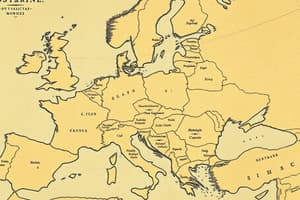Podcast
Questions and Answers
Christianity was the primary religion during the time of the Roman Empire.
Christianity was the primary religion during the time of the Roman Empire.
False (B)
Which of the following groups were NOT mentioned as invaders of the Roman Empire?
Which of the following groups were NOT mentioned as invaders of the Roman Empire?
- Persians (correct)
- Goths
- Vikings
- Huns
What caused the Germanic tribes to seek new lands?
What caused the Germanic tribes to seek new lands?
Increased difficulty in living conditions due to harsh climate
The Roman Empire's defeat was attributed to a weakened military and corruption among the _____ .
The Roman Empire's defeat was attributed to a weakened military and corruption among the _____ .
Match the following Germanic tribes with their descriptions:
Match the following Germanic tribes with their descriptions:
What was a result of the developments in agriculture during the Middle Ages?
What was a result of the developments in agriculture during the Middle Ages?
The Middle Ages were homogeneous in culture and religion.
The Middle Ages were homogeneous in culture and religion.
The emperors of the Roman Empire had titles such as Augustus, Caesar, and ______.
The emperors of the Roman Empire had titles such as Augustus, Caesar, and ______.
What significant event is commonly associated with the beginning of the Middle Ages?
What significant event is commonly associated with the beginning of the Middle Ages?
Match the following periods of the Middle Ages with their characteristics:
Match the following periods of the Middle Ages with their characteristics:
Flashcards are hidden until you start studying
Study Notes
Overview of the Dark Ages
- The Dark Ages marked the beginning of the Middle Ages in Europe, spanning from 476 CE to the fourteenth century.
- Characterized by wars, significant social and economic transformations, along with advancements in various fields.
Social Changes
- Agricultural innovations led to increased output, prompting the nobility to seek cash from surplus produce.
- Nobles viewed trade and manual labor as undignified, requiring intermediaries like millers, merchants, and bankers.
- The emergence of a burgeoning middle class accumulated wealth, changing the traditional social hierarchy.
Cultural Changes
- The Middle Ages were culturally diverse, contrasting with the more uniform Roman era.
- Military campaigns, particularly the Crusades, facilitated cultural exchanges among Germanic, Arab, and Christian societies.
- Increased cultural interaction fostered greater acceptance of varying societal differences.
Periodization of the Middle Ages
- The Middle Ages are divided into three main periods: Early, Central, and Late.
Early Middle Ages
- Prior to the fifth century, society functioned under Roman emperors, who held absolute power over the senate and military.
- Roman emperors carried titles including Augustus, Caesar, and Imperator, with religious authority as Pontifex Maximus.
- The Polytheistic Roman civilization gave way to Christianity as the prevailing faith during the Middle Ages.
Collapse of the Roman Empire
- The Roman Empire faced persistent threats from Germanic tribes such as the Huns, Goths, Vandals, and Vikings seeking new territories.
- Environmental challenges in their homelands contributed to these tribes' migrations.
- The Roman military, weakened by internal strife, could not efficiently defend against invasions.
- Nobility corruption exploited resources, hastening the Empire's economic decline.
- The defeat of emperors led to significant social, political, and economic restructuring post-collapse.
Studying That Suits You
Use AI to generate personalized quizzes and flashcards to suit your learning preferences.




